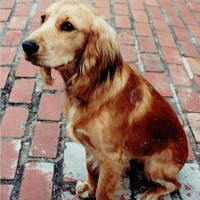Appearance of the Spantriever
|
| The Spantriever is a medium to large dog. At maturity, it will weigh around 22.5 kilos. It is likely to have a double coat with medium-length hair, although it can be as long as that of the English Cocker Spaniel parent. Coloration will largely depend on the dominant parental breed. It can be cream, red, black, fawn or gray. It may even be white or multicolored. He'll have floppy ears, which need special attention. He'll probably have feathers on his feet and legs. Feathers may also appear on the belly and tail. His tail is likely to be long and may curve slightly at the tip. It will be well muscled all over. It may also have webbed feet, depending on whether it inherited this trait from its Labrador Retriever parent. |
Temperament of the Spantriever
|
| The Spantriever is a very intelligent and loyal dog. He's energetic and can get into mischief if he doesn't get enough activity during the day. They get on very well with all members of the family, but especially with children of all ages. He's easy to train, and potty training is no problem for the Spantriever. He's affectionate and lively. He never meets strangers and can easily make friends with humans and other dogs. He'll also get along with other types of pets, provided he's properly socialized. Don't forget that he's a hunter at heart. He may tend to wander if you let him out without a leash or place him in an enclosed area. |
Needs and activities of the Spantriever
|
| The Spantriever is a rather active dog. It will need mental stimulation as well as physical activity. Provide him with toys that he can chew and that will provide mental activity. Allow him sufficient physical activity too. He'll love walking around the neighborhood with you; however, you should always make sure to keep him on a leash, unless you're in a fenced-in area. Speaking of a fenced-in area, make sure that the fence is at least 1.80 m high and that a good part of the board is buried so that he doesn't dig out of the enclosed area. Trips to the dog park are not a good idea, unless your Spantriever is very well trained. He has a tendency to run away if he's not on a leash. However, if he's very attentive to his master's wishes, he'll stay by your side, unless you allow him to do otherwise. |
Maintenance of the Spantriever
|
| Spantrievers can be very high-maintenance dogs, but this will depend on the type of coat they inherit from their parents. In this case, we'll assume he's acquired the double coat of the Labrador Retriever and the longhair of the English Cocker Spaniel. In this case, he should be brushed daily. Special care should be taken with the Spantriever's undercoat. Some owners may choose to shear the long hair that may accompany the Spantriever. In this case, daily brushing is still required. Give him a bath once a month to keep his hair clean. Brush his teeth every other day to prevent tartar build-up and bad breath. Brush his teeth daily to prevent tooth decay. Trim his nails every two weeks, unless he wears them out naturally. |









 English (United Kingdom)
English (United Kingdom)